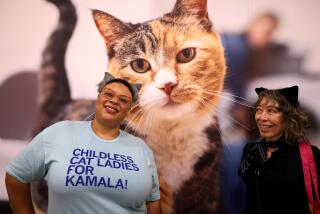Here’s a Breed of Leopard That Can Roam in Home
- Share via
Back in the 1960s, when it was legal to buy wild exotic pets in stores, Jean Mill did just that, in the hope of someday breeding a small, tame version of a leopard.
She has succeeded, even though she deplores capturing wild animals for sale, a practice that has contributed to the devastation of endangered species.
But in Mill’s case, the domestic cat leopard--called a leopardette and sometimes erroneously called a Bengal--lives on, thanks to her meddling with nature.
In 1963, she mated an Asian leopard cat with a black domestic tomcat, creating what she said may have been the first deliberate cross of wild and domestic species.
Her very best leopardette, developed after years of selective breeding, will be on display Sept. 26 and 27 at the International Cat Show in the Los Angeles Convention Center.
They are what Mill said she always hoped for: cats with the sleek, spotted pelts, white undersides and big feet of jungle felines; cats that can be held, petted and housebroken; cats that purr and are even safe with babies.
The Covina woman hopes to preserve a strain of wild spotted jungle cat that faces extinction because poachers want their pelts and because their natural habitat is disappearing. She breeds her species in a spacious yard behind her hillside ranch-style home.
Mill said she has always loved cats and began theorizing about cross-breeding while studying genetics at UC Davis in the 1940s. Her first experiments to produce a hybrid began 40 years ago, when she was one of three people in the country to successfully develop a long-haired Siamese cat. Now an established breed called Himalayan, such kittens are sometimes valued at more than $1,000 apiece.
Of the 35 species of felines, Mill said that only a few can successfully breed with domestic cats. Most hybrids are sterile, she said, but the small Asian jungle cat that produces females are fertile, while the males are not.
Mill briefly gave up breeding cats after she was widowed. Other people continued to produce the Asian leopard cat hybrids that are called Bengals. However, she said, none mated the animals beyond a second generation.
Ten years ago, after marrying Robert Mill and moving to a rural area of Covina, Mill returned to what she calls her “artistic creativity,” breeding third and fourth generations that are called leopardettes.
“I consider my work creative,” she said. “Other people paint with oils--I paint with genes. This is my gift. The point is to save the pattern (the markings) of endangered species, and we are close to getting the original markings.”
Mill and her husband, an inveterate traveler, sometimes go to extremes to get results.
For instance, while at a zoo in India in 1980, they learned of a stray spotted cat--a male Egyptian Mau--that lived there. They got it, went through the intricate process of having it inoculated and shipped to Los Angeles and mated it with female Asian leopard cat hybrids that they had acquired.
The result of these pairings have produced Mill’s best leopardettes, kittens that are alert and active, that make soft low sounds and have dark rings and tips on their tails. They all have amber eyes and their spotted coats are in several shades of copper, sorrel and silver. Mill said she expects that by next spring another generation of the cats will have more distinctive spots and consistent orange color.
This, she said, will be the result of “a painfully slow saga of excitement, tragedy, myriad litter boxes, government bureaucracy and cat-fancy resistance.”
She exhibits her cats at six or seven shows a year, enduring the bureaucratic processes of transporting animals to other states and countries. Several cat organizations have not yet accepted the new species, she said, because it is so new.
Meanwhile, a Los Angeles man, Paul Casey, has developed another breed of spotted cat by combining eight different breeds of domestic felines. His kittens, called “spangles,” were offered by Nieman-Marcus in its 1986 Christmas catalogue at $1,400 apiece. However, Mill said, these are an entirely different breed from her wilder-looking breed.
The leopardettes made their debut one year ago at the International Cat Show in Anaheim. They won an award for new breeds and received special recognition at a later show in Madison Square Garden. Mill said she intends to show them in Houston in November and in Paris next May.
She feeds the cats a dry food that is sold in pet stores, worms the kittens, gives them their inoculations, antibiotics and vitamins and does “as much as I possibly can myself,” Mill said.
Now the kittens are coming into their own, selling for between $600 and $1,000. Mill said the waiting list is long.
“It’s still a losing proposition,” Robert Mill said. “when you consider the traveling, hotel rooms, meals and veterinary bills.
“I know it. But I just love it,” his wife said. “This is my full-time work now.”
More to Read
Sign up for Essential California
The most important California stories and recommendations in your inbox every morning.
You may occasionally receive promotional content from the Los Angeles Times.













